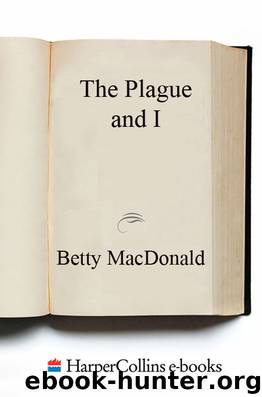The Plague and I by Betty Macdonald

Author:Betty Macdonald
Language: eng
Format: epub
Publisher: HarperCollins
Published: 2016-10-03T04:00:00+00:00
X
A Smile or a Scar
LESSON IX EXPLAINED the most common surgical methods used at The Pines to arrest tuberculosis. These were:
Artificial Pneumothorax—compression of the affected lung by the introduction of gas or filtered air into the pleural cavity (between the chest wall and the lung). Refills of air were first given every other day, then twice a week, once a week, once every two weeks, once a month, finally every four to six weeks. Pneumothorax was to be continued for a period of from two to four or more years.
Bilateral Pneumothorax—compression of both lungs by pneumothorax. Actually only a portion of both lungs was collapsed and patients taking bilateral pneumothorax, though short of breath, could lead moderately active lives.
Intrapleural Pneumolysis—cauterizing of adhesions between the chest wall and the lung. Such adhesions prevented a satisfactory collapse of the lung.
Thoracoplasty—removal of the ribs on one side of the thorax to accomplish a permanent collapse of the affected (diseased) part of that lung. This type of surgery was necessary when pleural adhesions prevented successful pneumothorax. The mortality rate in thoracoplastic surgery was so low as to be almost nonexistent.
Phrenicotomy—division or crushing of the phrenic nerve on one side causing elevation of the corresponding diaphragm, thus compressing the lower part of the lung on that side.
Extrapleural Pneumothorax—stripping the pleura from the chest wall (extrapleural pneumolysis) to form a pocket for pneumothorax or the use of oil (oleothorax). This operation, not altogether successful, is now seldom used, and was referred to by the patients as a “stripping,” and tactlessly explained by one of the nurses as “being similar to the operation performed by the butcher in making a pocket for stuffing in a roast.” Extrapleural pneumothorax was used when the involvement was not sufficient to warrant thoracoplasty but too many adhesions were present for intrapleural pneumolysis.
A successful collapse of the lung, whether it was accomplished by pneumothorax, thoracoplasty, phrenicectomy or stripping, favored rest for the infected part of the lung and facilitated healing of the disease. Collapsed lungs, being immobile, naturally healed more rapidly than working lungs, even though the working was kept at a minimum by complete bedrest. As the Medical Director had explained, collapsing a lung was like putting a splint on a broken leg.
Other forms of surgery now in use and new since my time include:
Pneumonectomy—removal of the entire affected lung.
Lobectomy—removal of an infected lobe of the lung.
When we were discussing the lesson on surgery, we were informed by Charlie, the store girl, or some other bad news distributor, that people with pulmonary tuberculosis could not take ether. At the time, as I remember, I made inquiry as to what anaesthesia was used in place of ether and was given the impression that the doctors merely knocked the patients down and ripped out their lungs, or adhesions or ribs, without benefit of anything stronger than an aspirin.
As The Pines commanded the services of the finest doctors in the city I knew that this was ridiculous so I asked the Charge Nurse about anaesthesia.
Download
This site does not store any files on its server. We only index and link to content provided by other sites. Please contact the content providers to delete copyright contents if any and email us, we'll remove relevant links or contents immediately.
We're Going to Need More Wine by Gabrielle Union(18072)
Bombshells: Glamour Girls of a Lifetime by Sullivan Steve(13108)
Pimp by Iceberg Slim(12931)
The Radium Girls by Kate Moore(10907)
Becoming by Michelle Obama(9290)
The Girl Without a Voice by Casey Watson(7262)
Educated by Tara Westover(7061)
Wiseguy by Nicholas Pileggi(4586)
The Wind in My Hair by Masih Alinejad(4424)
Hitman by Howie Carr(4376)
On the Front Line with the Women Who Fight Back by Stacey Dooley(4311)
Hunger by Roxane Gay(4216)
Year of Yes by Shonda Rhimes(4114)
The Rules Do Not Apply by Ariel Levy(3905)
The Borden Murders by Sarah Miller(3590)
Papillon (English) by Henri Charrière(3269)
Joan of Arc by Mary Gordon(3257)
Patti Smith by Just Kids(3227)
How to be Champion: My Autobiography by Sarah Millican(3186)
